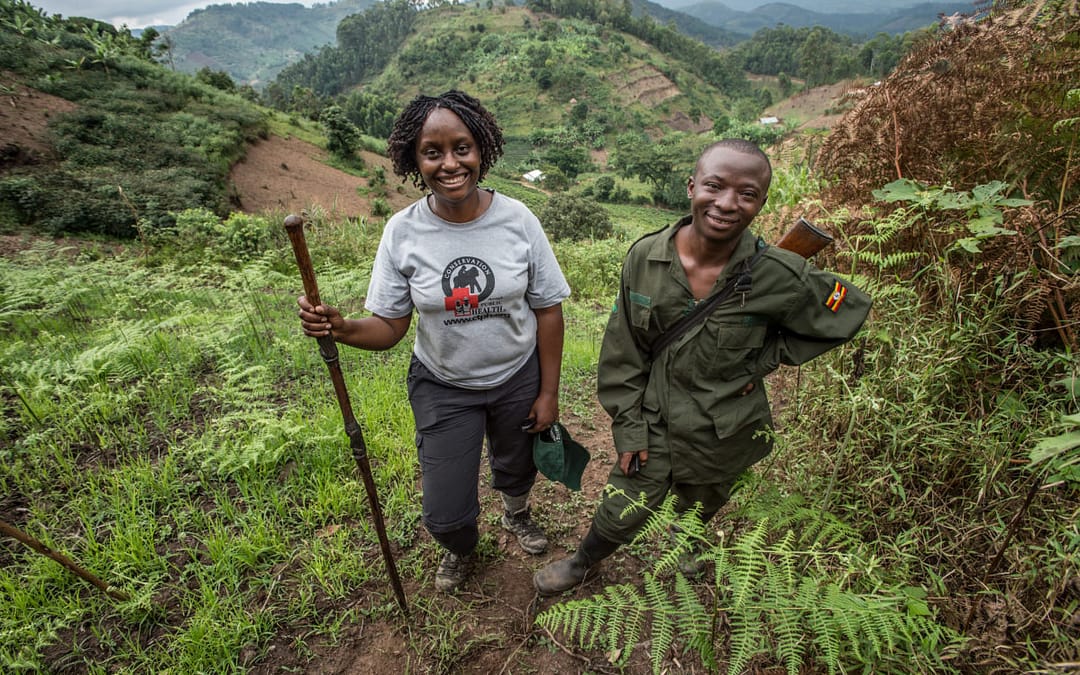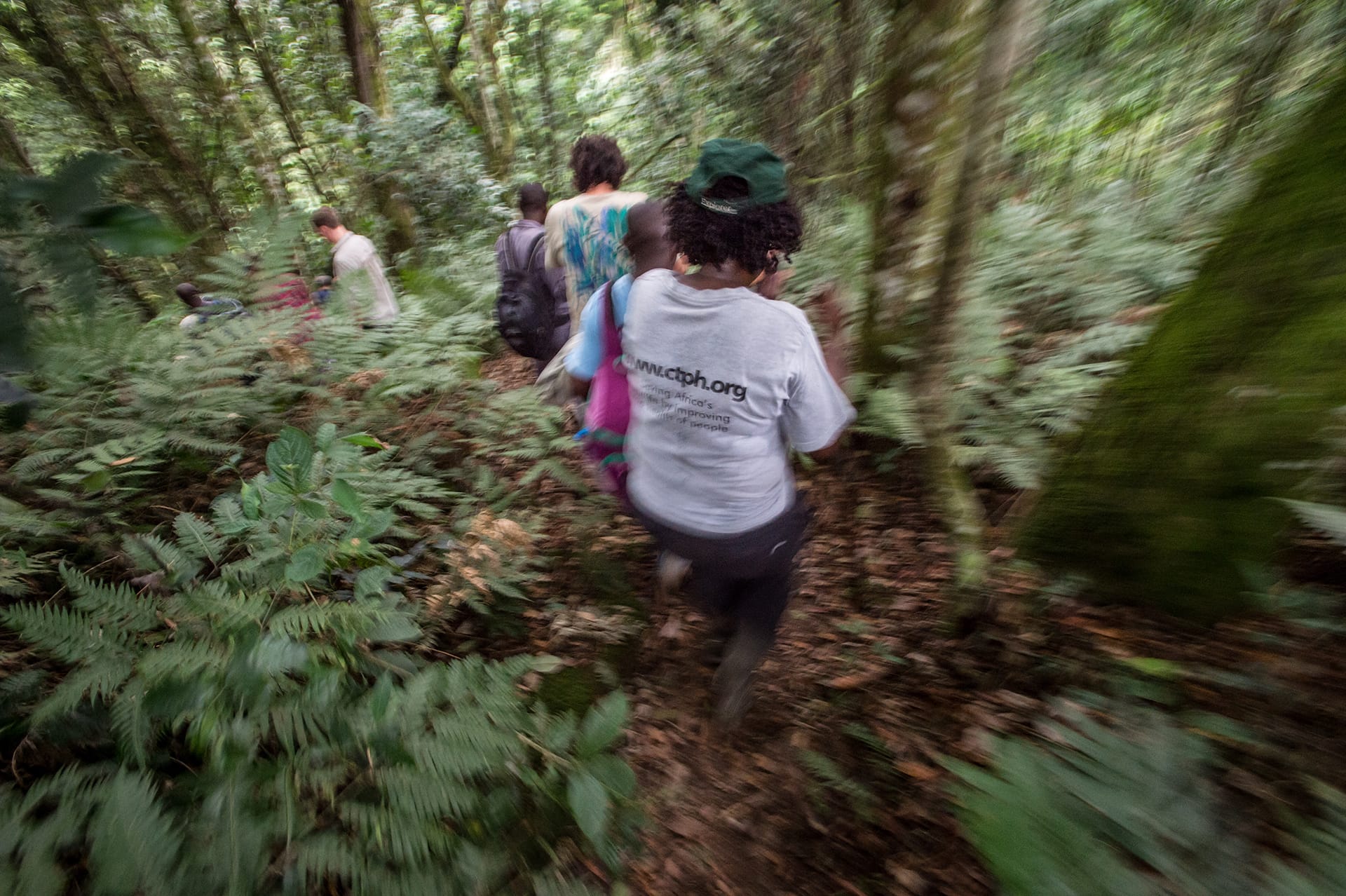
Dr. Gladys Kalema-Zikusoka
Dr. Gladys Kalema-Zikusoka
Protecting at-risk gorillas and humans in Bwindi Impenetrable Forest
Interview and photographs by Jo-Anne McArthur.
Text by Corinne Benedict.
Photo: Dr. Gladys with a park ranger in Bwindi Impenetrable Forest.
Kalema-Zikusoka had little equipment and no trained help, and the field rangers who’d called her disagreed over whether an operation should be attempted. Rectal prolapses are sometimes caused by inbreeding. Was it right to save a gorilla with bad genes?
The call was hers alone to make — she was the veterinarian, and she hadn’t become one to euthanize mountain gorillas.
“In 45 minutes, I was done and she was waking up,” Kalema-Zikusoka recalls. “And even those who said I shouldn’t do it ended up being happy that I did. When I presented [the case] at the American Association of Zoo Veterinarians meeting, everyone was like, ‘You did that yourself? You should have had a board-certified anesthesiologist, a board-certified surgeon.’ But I didn’t have that.”
Photo: Mist over Bwindi Impenetrable Forest.
“You just do what you can. You have to do it.”
In 2003, after discovering that humans were the source of a deadly scabies outbreak among Bwindi’s gorillas, Kalema-Zikusoka founded the nonprofit Conservation Through Public Health, or CTPH. Working in Uganda and Virunga National Park in the neighbouring Democratic Republic of Congo, CTPH focuses on improving the health of both people and gorillas, and on lifting communities out of poverty.
Photo: Bwindi Impenetrable Forest.
“In these fragile areas where wildlife, people, and livestock intersect, a decline in any of them affects the survival of the others,” says Kalema-Zikusoka, who is affectionately known here simply as Dr. Gladys.
Today, we realize how wildlife, humans, and ecosystems are all interconnected.
Photo: Walking into the forests of the Batwa Pygmy communities.
“We want them to be able to have this livelihood,” Kalema-Zikusoka says, “because it keeps them provided for and out of the forests.”
CTPH volunteers also provide house-to-house conservation education, changing attitudes by teaching people why it’s important to protect forests and gorillas and to limit contact with them.
“People used to kill gorillas in their gardens,” Kalema-Zikusoka says. “Now they don’t.”
Photo: A gorilla in Bwindi Impenetrable forest.
In the 1990s, the wild mountain gorilla population was estimated to be about 650. Today, it is around 880.
Growing up in Kampala, Kalema-Zikusoka remembers always having animals at home and being deeply concerned about their wellbeing. When one of her dogs or cats was sick, she’d refuse to go to school until she knew the animal was on the mend. By the time she was a teenager, she’d decided she wanted to be a wildlife veterinarian. She trained at the University of London’s Royal Veterinary College before establishing the first veterinary unit at the Uganda Wildlife Authority, then earning a master’s degree at North Carolina State University in the US.
Why gorillas?
“They’re very good mothers,” she says of gorillas. “Always with their babies.”
“I never get scared when they charge. They’re really nonviolent, the Buddhas of the great ape world. People say the chimp is who we are, and gorillas are who we want to be.”
“Helping animals helps people” she explains.
“We really need to extend our program there, but it’s difficult because of security.”
Photo: A park ranger in Bwindi Impenetrable Forest.
Kalema-Zikusoka is deliberate about making sure communities understand how gorillas have helped them, and she has helped raise the portion of tourism profits that must go directly to locals.
“Obviously the veterinary work is very important to me, because that’s my passion,” she says. “But then you realize the veterinary work can only help the sick, wild animals, but we’re really trying to save all the gorillas.”
“We spoke to our volunteers, asking, ‘OK, please educate your community that Ruhondeza is here to stay until he dies. He’s here because he trusts you. He’s seen you for over 20 years. He’s brought you a lot of wealth,’” Kalema-Zikusoka recalls.
Photo: The Gorilla Coffee plantations and agriculture in southern Uganda.
“And they understood. They said, ‘Oh, when one of our own gets old, we look after them.’”
Text by Corinne Benedict. Interview and photographs by Jo-Anne McArthur.






































